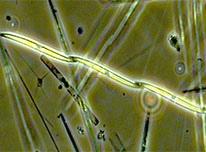Diatoms are unicellular algae responsible for 20% of the oxygen production on Earth. Knowledge of the mechanisms that regulate their life cycles is essential to understand the dynamics of phytoplankton populations and algal blooms at sea.
Being unicellular does not imply a 'simple' life cycle: diatoms reproduce by binary fission but different species also have a sexual reproduction phase involving 'male' and 'female' cells. Diatoms have a rigid siliceous cell wall that causes a progressive reduction of the cell size at each division. Sexual reproduction, in addition to allowing exchange of genetic material, in these organisms also allows to restore the initial size, thus preventing the extinction of the population.
 The team led by Dr. Ferrante and Montresor, after sequencing the genome of Pseudo-nitzschia multistriata, undertook a study aimed at understanding the mechanism of sex determination by analyzing the differences at the genomic level between the two sexes, called 'mating type', which in this species are distinguished in (+) and (-).
The team led by Dr. Ferrante and Montresor, after sequencing the genome of Pseudo-nitzschia multistriata, undertook a study aimed at understanding the mechanism of sex determination by analyzing the differences at the genomic level between the two sexes, called 'mating type', which in this species are distinguished in (+) and (-).
From the analysis of the differential gene expression between the two different mating types, a number of genes were obtained whose expression was differently regulated. In particular, 3 genes specific for mating type (+) and 2 genes specific for mating type (-) were identified. The sequences of these genes could be amplified from the genomic DNA of mating type (+) and (-) strains. It was therefore not the presence or absence of sequences encoding genes to distinguish the genome of the two mating types, but a short tandem repeat sequence in the regulatory region of MRP3, a gene that is exclusively expressed in the mating type (+). By analyzing 86 strains, 4 possible alleles of different lengths were identified and it was found that one of these alleles always segregates with the mating type (+).
To provide a functional evidence of the role of the MRP3 gene in sex determination, its expression was induced in (-) cells and it was observed that this change could reverse the mating type. Quantitative PCR analysis and massive transcriptome sequencing allowed to understand that the expression of the other 4 genes specific for the two different mating types varies according to the expression of MRP3. This allowed to demonstrate that MRP3 is the master gene in the sex determination process. The discovered mechanism is the first one described for diatoms for which nothing related to this topic was known.
MRP3, whose biological function remains unknown, is conserved in other species belonging to the genus Pseudo-nitzschia and in the diatom Fragilariopsis cylindrus, but it is not known whether it can have a similar function in these species. No other homologues of MRP3 in diatoms that are phylogenetically more distant from Pseudo-nitzschia were found, but this is not surprising given the high plasticity observed in the mechanisms of sex determination even in phylogenetically related organisms.
Finally, the discovery represents a starting point for the control of the proliferation of these organisms, often used also in the biotechnological field, providing, in this way, the bases for the production of food, bioenergy and materials. For these reasons, a project focused on the mechanisms regulating sexual reproduction in plankton has recently received substantial funding from the American foundation Gordon and Betty Moore, which has been investing for years in the development of model systems in marine biology.
Monia T. Russo, Laura Vitale, Laura Entrambasaguas, Konstantinos Anestis, Neri Fattorini, Filomena Romano, Carmen Minucci, Pasquale De Luca, Elio Biffali, Wim Vyverman, Remo Sanges, Marina Montresor, Maria I. Ferrante. MRP3 is the sex determining gene in the diatom Pseudo-nitzschia multistriata. Nature Communications, 28 November 2018, doi: 10.1038/s41467-018-07496-0.










